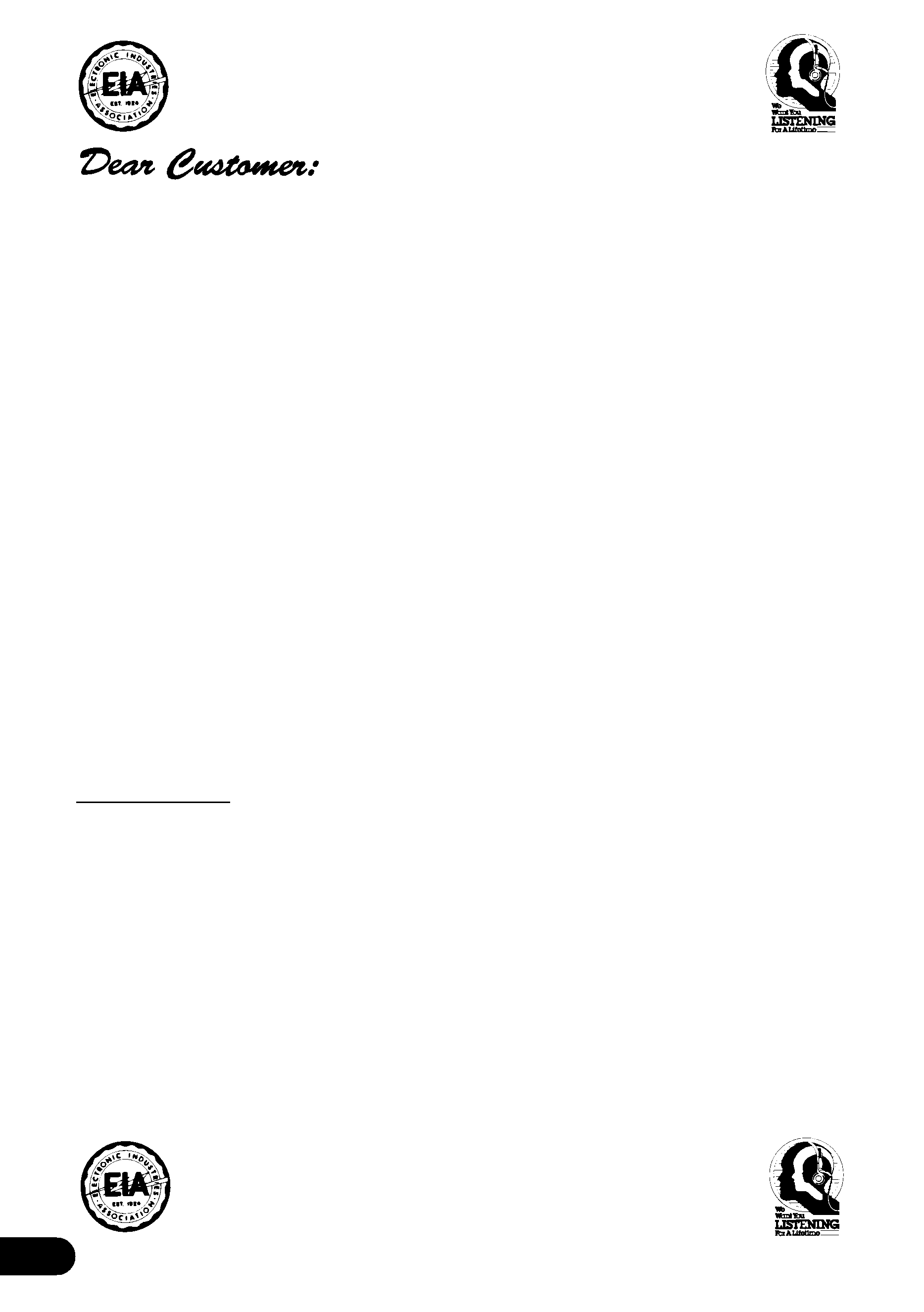
Multi-CD control DSP High power CD Cassette
player with FM/AM tuner
Syntoniseur FM/AM-CD-cassette, puissante
amplification, contrôleur DSP pour lecteur CD à chargeur
Operation Manual
FH-P8800
Mode d'emploi
ENGLISH
FRANÇAIS
ESPAÑOL

1
Contents
Dear Customer ............................................ 3
Key Finder .................................................... 4
-
Head Unit (Close)
-
Head Unit (Open)
-
Remote Controller
Remote Controller and Care .................... 6
Using the Remote Controller ............................ 6
Batteries ............................................................ 6
Before Using This Product ...................... 7
About This Product .......................................... 7
About This Manual ............................................ 7
-
About Display Indications
Important .......................................................... 7
Resetting the Microprocessor ............................ 7
Precaution .......................................................... 8
After-sales Service for Pioneer Products .......... 8
Basic Operation ........................................ 9
To Listen to Music ............................................ 9
Setting the Display Angle .............................. 10
Basic Operation of Tuner ................................ 11
-
Manual and Seek Tuning
-
Preset Tuning
-
Band
Basic Operation of Built-in CD Player .......... 12
-
Eject
-
Disc Loading Slot
-
Track Search and Fast Forward/Reverse
Basic Operation of Cassette Player ................ 13
-
Open/Eject
-
Direction Change
-
Fast Forward/Rewind and Music Search
-
Cassette Loading Slot
Basic Operation of Multi-CD Player .............. 15
-
Track Search and Fast Forward/Reverse
-
Disc Search
-
Disc Number Search
(for 6-Disc, 12-Disc types)
Corresponding Display Indications and
Buttons ...................................................... 16
Entering the Function Menu ............................ 17
Function Menu Functions ................................ 17
Entering the Detailed Setting Menu ................ 19
Detailed Setting Menu Functions .................... 20
Tuner Operation ...................................... 21
-
Local Seek Tuning (LOCAL)
-
Best Stations Memory (BSM)
Using the Built-in CD Player .................. 22
-
Repeat Play (REPEAT)
-
Random Play (RANDOM)
-
Scan Play (T.SCAN)
-
Pause (PAUSE)
-
Compression and DBE (COMP/DBE)
-
Disc Title Input (TITLE IN)
-
Displaying Disc Title
CD TEXT Function ........................................ 24
Using the Cassette Player ...................... 25
-
Repeat Play (REPEAT)
-
Scan Play (SCAN)
-
Blank Skip (B.SKIP)
-
Radio Intercept (RI)
-
Dolby B NR (B NR)
Using Multi-CD Players .......................... 27
-
Repeat Play (REPEAT)
-
Random Play (RANDOM)
-
Scan Play (SCAN)
-
Pause (PAUSE)
ITS (Instant Track Selection) .......................... 29
-
ITS Programming (ITS)
-
ITS Play (ITS.PLAY)
-
Erase a Track Program
-
Erase a Disc Program
Disc Title ........................................................ 31
-
Disc Title Input (TITLE IN)
-
Selecting Discs by
Disc Title List (TITLE LIST)
-
Displaying Disc Title
Compression and DBE (COMP/DBE) ............ 33
-
COMP/DBE ON/OFF Switching
CD TEXT Function (for CD TEXT
compatible type) ...................................... 33
-
Title Display Switching
-
Title Scroll
Playing Discs on a 50-Disc Type
Multi-CD Player ...................................... 34

Audio Adjustment .................................... 35
Entering the Audio Menu ................................ 35
Audio Menu Functions .................................... 35
-
Balance Adjustment (FADER)
-
Subwoofer Output (SUB.W)
-
Subwoofer Setting Adjustment (80Hz)
-
Loudness Adjustment (LOUD)
-
Source Level Adjustment (SLA)
Using the Digital Signal
Processor (DSP) ................................ 38
Entering the DSP Menu .................................. 38
DSP Menu Functions ...................................... 38
-
Graphic Equalizer
-
Recalling the Equalizer Curves
-
13-Band Graphic Equalizer Adjustment
Position Selector .............................................. 40
-
About the Position Indicator
-
Setting the Listening Position (POSITION)
Auto-equalizing Function ................................ 41
-
Before Operating the Auto-equalization
-
Auto-equalizing
-
Error Cords of Auto-equalizing Function
Initial Setting ............................................ 45
Entering the Initial Setting Menu .................... 45
Initial Setting Menu Functions ........................ 46
-
Setting the Time
-
Setting the Calender
-
Setting the Clock Display (CLOCK)
-
Switching the AUX Mode (AUX)
-
Setting the Dimmer (DIMMER)
-
Selecting the Digital Attenuator (DIG.ATT)
-
Selecting the Contrast (CONTRAST)
Other Functions ........................................ 49
Volume Attenuator .......................................... 49
Switching the Display .................................... 49
About the Demonstration Mode ...................... 49
Using the AUX Source .................................... 50
-
Selecting the AUX Source
-
AUX Title Input
Cellular Telephone Muting ............................ 50
CD Player and Care .................................. 51
Precaution ........................................................ 51
Built-in CD Player's Error Message .............. 51
Cassette Player and Care ...................... 52
Precaution ........................................................ 52
-
About the Cassette Player
-
About Cassette Tapes
Cleaning the Head .......................................... 52
Specifications .......................................... 53
2
ENGLISH
ESPAÑOL
DEUTSCH
FRANÇAIS
ITALIANO
NEDERLANDS

3
Selecting fine audio equipment such as the unit you've just purchased is only the start of your
musical enjoyment. Now it's time to consider how you can maximize the fun and excitement your
equipment offers. This manufacturer and the Electronic Industries Association's Consumer
Electronics Group want you to get the most out of your equipment by playing it at a safe level.
One that lets the sound come through loud and clear without annoying blaring or distortion--and,
most importantly, without affecting your sensitive hearing.
Sound can be deceiving. Over time your hearing "comfort level" adapts to higher volumes of
sound. So what sounds "normal" can actually be loud and harmful to your hearing. Guard against
this by setting your equipment at a safe level BEFORE your hearing adapts.
To establish a safe level:
· Start your volume control at a low setting.
· Slowly increase the sound until you can hear it comfortably and clearly, and without distor-
tion.
Once you have established a comfortable sound level:
· Set the dial and leave it there.
Taking a minute to do this now will help to prevent hearing damage or loss in the future. After all,
we want you listening for a lifetime.
We Want You Listening For A Lifetime
Used wisely, your new sound equipment will provide a lifetime of fun and enjoyment. Since
hearing damage from loud noise is often undetectable until it is too late, this manufacturer and the
Electronic Industries Association's Consumer Electronics Group recommend you avoid pro -
longed exposure to excessive noise. This list of sound levels is included for your protection.
Decibel
Level
Example
30
Quiet library, soft whispers
40
Living room, refrigerator, bedroom away from traffic
50
Light traffic, normal conversation, quiet office
60
Air conditioner at 20 feet, sewing machine
70
Vacuum cleaner, hair dryer, noisy restaurant
80
Average city traffic, garbage disposals, alarm clock at two feet.
THE FOLLOWING NOISES CAN BE DANGEROUS UNDER CONSTANT EXPOSURE
90
Subway, motorcycle, truck traffic, lawn mower
100
Garbage truck, chain saw, pneumatic drill
120
Rock band concert in front of speakers, thunderclap
140
Gunshot blast, jet plane
180
Rocket launching pad
Information courtesy of the Deafness Research Foundation.

4
ENGLISH
ESPAÑOL
DEUTSCH
FRANÇAIS
ITALIANO
NEDERLANDS
Key Finder
Head Unit (Close)
Head Unit (Open)
Operate buttons 1 to 6 after opening the front panel.
Refer to page 10 for details on how to open the front panel.
Cassette loading slot
Buttons 1 to 3
Buttons 4 to 6
ANGLE buttons
LOUDNESS button
CD EJECT button
Disc loading slot
AUDIO button
5//2/3 buttons
FUNCTION button
SOURCE button
BAND button
DSP button
SCROLL button
VOLUME
ATTENUATOR button
TAPE EJECT button
DISPLAY button
